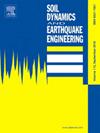Mechanical properties of monolithic EPS-coated lightweight soil: unconfined compressive strength and small-strain dynamic characterization
IF 4.2
2区 工程技术
Q1 ENGINEERING, GEOLOGICAL
引用次数: 0
Abstract
Expanded polystyrene (EPS) foam lightweight soil, a novel lightweight geomaterial, offers significant advantages in addressing the challenges of soft ground settlement and slope instability. To address the issue of inconsistent EPS particle distribution, this study presents a new material called monolithic EPS-coated lightweight soil (MECS) structure. The static strength characteristics and small strain dynamic response characteristics of MECS were investigated by conducting unconfined compressive strength tests and resonant column tests. The results show that (1) MECS exhibits a typical shear damage mode under uniaxial compression conditions, and its unconfined compressive strength (qs) is inversely proportional to the thickness (T) of the EPS sleeve. (2) In the small strain range, the dynamic shear modulus (G) of MECS decreases with increasing T, but increases with increasing confining pressure (P). The dynamic shear modulus-dynamic shear strain curve (G - γc) exhibits clear decay characteristics, with an accelerated decay when γc > 10-3 (T influence) and γc > 10-4 (P influence). (3) A relationship connecting qs and the initial dynamic shear modulus (G0) has been formulated. By modifying the Hardin-Drnevich model, it becomes possible to accurately predict the normalized dynamic shear modulus decay curve for MECS in the small strain range. This curve exhibits a typical inverse “S" shape distribution characteristic. (4) The damping ratio (D) of MECS is positively associated with the T and negatively linked to the P. The damping ratio - dynamic shear strain curve (D - γc) shows a growing trend, and the growth rate increases with the increase of γc. The maximum damping ratio (Dmax) shows an “S” shape growth with the increase of T, and a “C” shape decrease with the increase of P. Research shows that Romo's empirical formula precisely captures the damping characteristics of MECS and offers a dependable approach for quantitatively analyzing the D within the small strain scope. The research furnishes a critical theoretical groundwork and technical assistance for the wide application of MECS in soft soil foundation construction.
单片eps包覆轻质土的力学特性:无侧限抗压强度和小应变动态特性
膨胀聚苯乙烯(EPS)泡沫轻质土是一种新型轻质岩土材料,在解决软土地基沉降和边坡失稳问题方面具有显著优势。为了解决EPS颗粒分布不一致的问题,本研究提出了一种名为单片EPS包覆轻质土(MECS)结构的新材料。通过无侧限抗压强度试验和共振柱试验,研究了MECS的静强度特性和小应变动态响应特性。结果表明:(1)MECS在单轴压缩条件下表现为典型的剪切破坏模式,其无侧限抗压强度qs与EPS套筒厚度T成反比;(2)在小应变范围内,MECS动剪切模量(G)随T的增加而减小,随围压(P)的增加而增大。动态剪切模量-动态剪切应变曲线(G - γc)表现出明显的衰减特征,当γc >;10-3 (T影响)和γc >;10-4 (P影响)。(3)建立了qs与初始动剪切模量G0的关系式。通过对Hardin-Drnevich模型的修正,可以准确预测MECS在小应变范围内的归一化动态剪切模量衰减曲线。该曲线呈典型的反“S”形分布特征。(4) MECS的阻尼比(D)与T呈正相关,与p呈负相关,阻尼比-动态剪切应变曲线(D - γc)呈增长趋势,且随着γc的增加,增长率增大。最大阻尼比(Dmax)随T的增加呈“S”型增长,随p的增加呈“C”型下降。研究表明,Romo经验公式准确地反映了MECS的阻尼特性,为小应变范围内定量分析D提供了可靠的方法。该研究为MECS在软土地基施工中的广泛应用提供了重要的理论基础和技术支持。
本文章由计算机程序翻译,如有差异,请以英文原文为准。
求助全文
约1分钟内获得全文
求助全文
来源期刊

Soil Dynamics and Earthquake Engineering
工程技术-地球科学综合
CiteScore
7.50
自引率
15.00%
发文量
446
审稿时长
8 months
期刊介绍:
The journal aims to encourage and enhance the role of mechanics and other disciplines as they relate to earthquake engineering by providing opportunities for the publication of the work of applied mathematicians, engineers and other applied scientists involved in solving problems closely related to the field of earthquake engineering and geotechnical earthquake engineering.
Emphasis is placed on new concepts and techniques, but case histories will also be published if they enhance the presentation and understanding of new technical concepts.
 求助内容:
求助内容: 应助结果提醒方式:
应助结果提醒方式:


